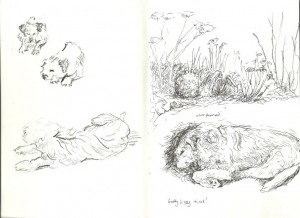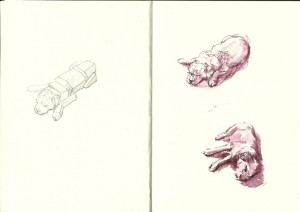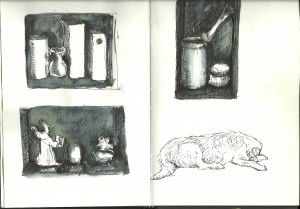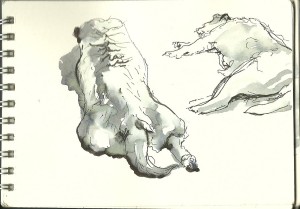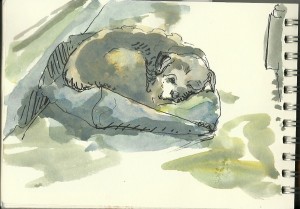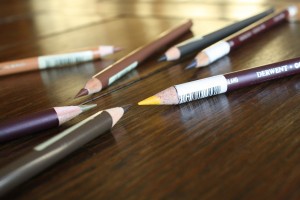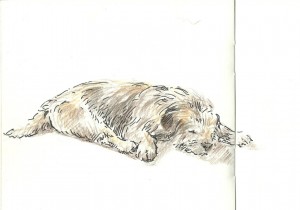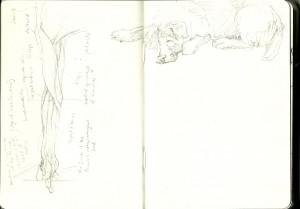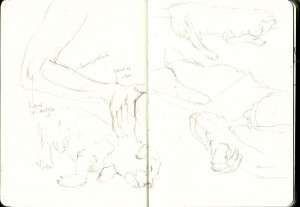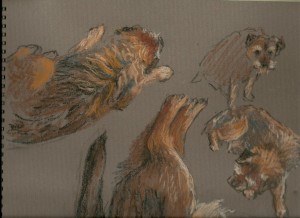Sketching pets: which medium to use
May 27, 2012
Sketching pets in various media
Today I discuss which media are best suited to sketching your pet. The illustrations here are pictures from my own sketchbooks, mostly of my Border Terrier, Freddy.
Pen and ink drawing
For the last few years, pen and ink has been the main medium used in my sketchbooks. Both rollerball and cartridge-type pens are wonderfully convenient. There is no mess, they do not spill, fade or smudge. Wherever I go, I usually carry a sketchbook and pen in my bag.
The double-page spread, above, illustrates the adaptability of pen lines for both fl uid “loose” sketching and for a more detailed build-up of detail.
uid “loose” sketching and for a more detailed build-up of detail.
My current favourite sketching pens are Artpens made by Rotring. These have a slightly flexible nib that can produce a “lively” line. I prefer the feel of old-fashioned dip pens even to my Artpens, but, following an incident, am now too nervous of spilling ink to take a dip pen and ink bottle around with me for sketching. The Artpens (“Fine” and “Extra fine”) are a good second best to dip pens.
Above are two drawings made with an Artpen, showing how detail can be built up with crosshatching and fur can be suggested using lines.
Here I had a day of being curious about how things looked from different angles:
In the sketchbook, below, I sat down and drew both plants and my dog with some attention to detail on the right-hand page, again using an Artpen.
The bolder drawings on the left-hand page were drawn in black chinagraph pencil which I shall discuss more fully later in this post.
The only cartridges that can be used in an Artpen are made by Rotring themselves. These are available in various colours. So far I have tried out black and brown inks and these are both watersoluble. A brush pen filled with plain water is handy for working back into the pen lines.
Both the black and brown inks take on a rather purplish tone when water is added. The following drawings (right-hand side of the book) were done with brown Rotring ink in the pen:
See how much bolder the ink drawings look (above) compared with the pencil drawing on their facing page.
Watercolour
I don’t seem to have used watercolour very often for drawing my dog. It can be used very informally in a sketchbook just to fill areas in with a wash of colour. I like to combine watercolour with pen or pencil lines when sketching, often using up whatever colour is left on my palette:
Brush and ink
In the sketchbook, below, I was working on ideas for a still-life picture. The lines for these drawings were made with an Artpen, then dark tone was added using black Daler-Rowney FW ink and a brush. I’ve included this double-page here to show you how this does give quite a striking effect within the sketchbook. Once again, the dog found his way onto the page as a line drawing:
If you are careful to avoid spillage, dilute ink can be carried about in a container and added to a line drawing as you work:
Black Quink ink tends to separate into subtle colours when diluted with water, and this produces an interesting effect:
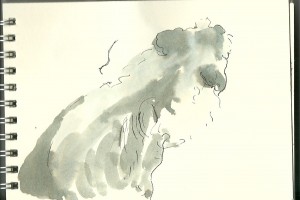
Coloured pencils
The pencils shown above are from the Faber-Castell Polychromos and Derwent Coloursoft ranges, and were used in this drawing:
A few black pen lines were included to increase the definition of the drawing.
The range of wonderful coloured pencils available is tempting. I need little excuse to visit the art shop and to choose yet more colours. A few strokes of one pencil can be used to suggest the exact colour of an animal’s tuft of hair, or light strokes can be layered to blend the colour. Derwent Coloursoft pencils are particularly blendable.
Pencil
Pencil is handy for sketching in that it is very easy to carry around, and is easily erased if errors occur. Unfortunately, it smudges and fades unless fixed, and does not have much impact or reproduce well.
In the following images, I was drawing my own arm in pencil, but then got distracted by the dog who is of course far more interesting:
Chinagraph pencil
Normal coloured pencils produce subtle lines and are easily smudged. For bold, permanent lines consider using a chinagraph pencil. Below is a detail from a double page of my sketchbook. The dog was drawn in coloured pencils and pen, then the rabbits were added in black chinagraph pencil:
The waxy chinagraph pencils are available in black, white and a limited range of other colours. I do find it difficult to keep them sharp, and they easily break when I re-sharpen them. Aside from this frustration, they are great for sketchbook work as they do not smudge at all and encourage a bold, direct approach.
Working in soft pastel
For a completely different effect, try sketching in pastels. Keep the colours simple. It helps to start off each picture with just four colours of your choice: Pick a warm light colour (e.g. a cream), a cool light colour (e.g. a bluish light grey) and a warm and a cool dark colour. In the image below, I used a stick of soft willow charcoal for some of the initial drawing:
The available range of pastel colours is amazing. Once again, I find it hard to stop buying when I am in the art shop. My favourite brand for softness and delicious colour is Unison (right):
I also love to use conte sticks which have a much firmer texture:
For sketching, the main drawback with pastels is their tendency to smudge. They can also leave your hands, bag and surroundings covered with powder.
You may get away with using a little firm conte crayon in your routine sketchbook (leave the facing page blank), but it is advisable to use a dedicated pastel book to protect your work. I like the Daler-Rowney pastel books, which come with textured paper of assorted colours. Each page is protected by its own piece of greaseproof-type paper, so your work won’t smudge when you turn the page.

Looking ahead…
I am looking forward to the next horse life drawing class which is set for Sunday June 17th:
https://art2art.org.uk/workshops/equestrian-life-drawing-sunday-june-17
Do contact me to reserve your place.
My next post will probably be related to drawing horses. Let me know if you have any special requests for post topics, otherwise just watch this space!




